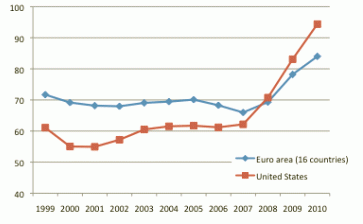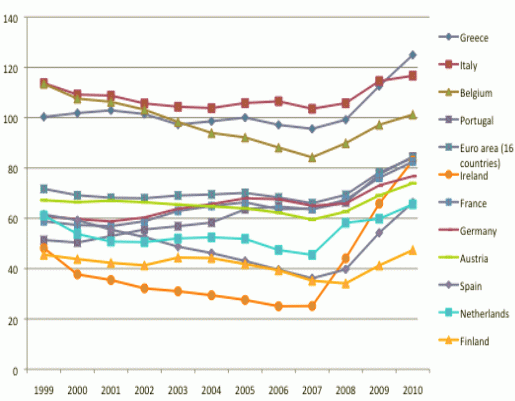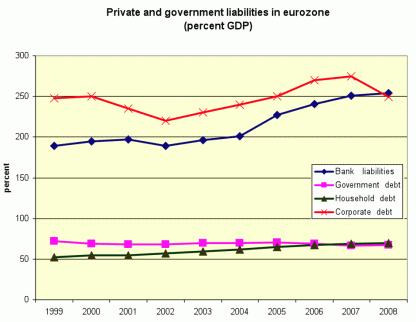A government debt crisis is ravaging the Eurozone. Yet when comparing the development of government debt in the Eurozone with that of the US it is striking to find how much more benign the trends in sovereign debt are in the Eurozone compared to the US.
This is made clear in Figure 1, which shows the debt to GDP ratios in the Eurozone and the US since 1999. Prior to the eruption of the financial crisis in 2007, the two debt ratios were converging, i.e. the Eurozone government debt ratio tended to decline while the US government debt ratio tended to increase. Since the start of the financial crisis we observe a significantly faster increase of the government debt ratio in the US than in the Eurozone. In 2010 the US government debt ratio will be 10 percentage points higher than in the Eurozone.
Figure 1. General government consolidated gross debt
Source: European Commission, AMECO
An outsider looking at this figure would surely conclude that if one country is likely to be hit by a sovereign debt crisis it should be the US, not the Eurozone. If there has been government profligacy (as is now often claimed to be the cause of the debt crisis in the Eurozone) it seems to be the case more in the US than in the Eurozone. Yet it is the Eurozone that is hit by the crisis. Why?
Hidden differences and no mechanism
The answer is to be found in the fact that the average debt to GDP ratio of the Eurozone hides large differences between countries and that the Eurozone does not have a mechanism to deal with these differences. Let us first concentrate on the size of the differences. These are shown in Figure 2.
Figure 2. General government consolidated gross debt
Source: European Commission, AMECO
The differences are striking. Some countries like Greece and Italy have very high public debt levels, others such as Ireland and Spain have public debt levels that are increasing fast. This situation has raised concerns about the capacity of these countries to continue to service their debts in an environment of low economic growth. A majority of countries in the Eurozone, however, experience a debt dynamics that is benign certainly when compared to the US (and also the UK).
Given the overall strength of the government finances within the Eurozone it should have been possible to deal with a problem of excessive debt accumulation in Greece, which after all represents only 2% of Eurozone GDP. Yet it has appeared impossible to do so. The reason is that there is no mechanism to “internalise” this problem, i.e. to automatically organise transfers to the country experiencing these problems. As a result, the Greek sovereign debt crisis was left hanging high and dry, triggering in turn contagion to other countries that the market perceived to be next in line for possible default.
The contrast with the US is stark. Deficit and surplus regions also exist in the US. These divergences however are considerably alleviated by the fact that the centralised Federal budget automatically redistributes to the deficit regions without anyone noticing. It has been estimated that for every dollar decline in income at the state level, between 0.2 and 0.4 dollars flow back to the state through the federal budget (see for example Sachs and Sala-i-Martin 1989, Von Hagen 1991, and Asdrubali et al. 1996).
What is the Eurozone missing?
The heart of the problem is that the Eurozone is a monetary union without being a political union. In a political union there is a centralised budget that provides for an automatic solidarity mechanism in times of crisis. This is absent in the Eurozone (see Asdrubali et al. 1996 and Mélitz and Zumer 1999. For a survey, see De Grauwe 2009).
Automatic transfers do not solve the problem of adjustment of states or countries, but they reduce the need for the deficit state or country to borrow in the capital markets. Thus the existence of a centralised budget creates an automatic solidarity (insurance) mechanism allowing countries to draw on the resources of other countries when facing a negative shock, without the need to organise an explicit decision making process. Many economists have stressed in the past that such an insurance mechanism is essential for a smooth functioning of the monetary union (in the economists’ jargon, to ensure optimality of a monetary union). They appear to be vindicated today.
An explicit fiscal union is not the only way to provide for an insurance mechanism within a monetary union. It can also be organised using the technique of a monetary fund that obtains resources from its members to be disbursed in times of crisis (and using a sufficient amount of conditionality). Such a proposal has recently been made by Gros and Mayer (2010).
The design of the Eurozone, however, completely discarded any form of automatic insurance mechanism. The main reason was that, as with any insurance mechanism, there is the risk of moral hazard. This is the risk that governments will exploit the existence of an insurance mechanism to create excessive debts and deficits. The need to avoid moral hazard was the main reason why the Eurozone was created without any insurance mechanism.
While it is understandable that countries were not willing to automatically transfer resources to deficit countries it is less understandable that so many lived in the illusion that a monetary union could function smoothly without it. The present crisis shows that even if countries never intended to provide assistance to others, events can force them to do so. In much the same way, governments never intended to save banks, but when a banking crisis erupted, their hands were forced. Likewise, at some point a monetary union will force member countries to show some solidarity – whether they like it or not. The trouble with the Eurozone is that when events force countries to practice solidarity there is no mechanism to do this smoothly.
A fire code without a fire brigade
The official doctrine in the Eurozone has been that an insurance mechanism is not necessary for a smooth functioning of the Eurozone. The Stability and Growth Pact would do the trick – just make sure that countries abide by the rules. If they do so, i.e. if they are always well-behaved, there is no need for an automatic insurance mechanism provided by a centralised budget, or by a European Monetary Fund. This is like saying that if people follow the fire code regulations scrupulously there is no need for a fire brigade. The truth is that there will always be some people who do not follow the rules scrupulously, making a fire brigade necessary. And an important detail: This fire brigade should be willing to extinguish the fire before it punishes the guilty.
Thus it can be said that the Eurozone had an elaborate set of rules to prevent fires and decided that therefore it would not need a fire brigade. When it finally set up a fire brigade, the latter was busy trying to punish the guilty before it started extinguishing the fire. No wonder the fire spread to other countries.
The recent proposals developed by the European Commission, under pressure from the German government, continue to follow the logic of strengthening the fire code rules and ignoring the need to create a fire brigade that is willing to extinguish the fire before it punishes the reckless. It is clear that this approach is not workable once a crisis erupts.
Policymakers using incorrect analysis of the fundamentals
In addition, the diagnosis of the causes of the crisis underlying these proposals is wrong. Let me elaborate on this.
- It is now repeated continuously that the source of the debt crisis in the Eurozone is the profligacy of national governments. As was stressed earlier, prior to the emergence of the financial crisis the government debt to GDP ratio in the Eurozone was declining.
- During the same period, private debt (households and financial institutions) increased in an unsustainable way. This is shown in Figure 3.
Figure 3. Private and government liabilities in the Eurozone (share of GDP)
Source: European Commission, AMECO, and CEPS
While the government debt ratio in the Eurozone declined from 72% in 1999 to 67% in 2007) the household debt increased from 52% to 70% of GDP during the same period. Financial institutions increased their debt from less than 200% of GDP to more than 250%.
- With the exception of Greece, the Eurozone governments were more disciplined than the private sector in containing their debt.
- The explosion of the government debt after 2007 was the result of a necessity to save the private sector, in particular the financial sector.
Those who say that it is government profligacy that is the source of the debt crisis are mistaken. They also fail to see the inevitable connection between private and public debt. This connection is particularly strong in countries like Spain and Ireland that have been hit badly by the debt crisis.
As can be seen from Figure 2, Spain and Ireland were spectacularly successful in reducing their government debt to GDP ratios prior to the financial crisis, i.e. Spain from 60% to 40% and Ireland from 43% to 23%. These were the two countries, which followed the rules of the Stability and Growth Pact better than any other country – certainly better than Germany that allowed its government debt ratio to increase before 2007. Yet the two countries, which followed the fire code regulations most scrupulously, were hit by the fire, because they failed to contain domestic private debt.
A fire code without a fire brigade: Fighting the wrong enemy
The European Commission’s recent proposals continues to follow the philosophy still that the fire code regulations must be strengthened while nothing is done to create an effective fire brigade. In this sense the Commission is fighting the wrong enemy.
This “fighting-the-wrong-enemy” syndrome is even more pronounced in the recent proposal made by the German government to impose balanced budget rules in all the Eurozone countries. Such a proposal, if implemented, would do little to avoid the kind of crisis that the Eurozone experiences now.
This has everything to do with the build-up of major imbalances involving the private sector. As argued earlier, some countries (not only in Southern Europe) allowed unsustainable real estate and consumption booms to emerge and to be financed by bank debt. Much of the financing of these unsustainable booms was done by the “virtuous” countries with current-account surpluses. These imbalances will occur even when all countries follow balanced budget rules. Thus it appears that the German government’s proposal to install balanced budget rules is a major cover-up of its own responsibility in contributing to the imbalance within the Eurozone.
In all fairness it should be added that there is an important new and positive element in the recent Commission’s proposals. This is that not only the government budget debts and deficits must be monitored, but also the private sector imbalances, in particular private debt levels. The issue here is how this monitoring can be made effective so as to avoid new crises. One can have doubts whether this can be achieved without a further transfer of sovereignty to European institutions.
Conclusion
It has often been said, but it cannot be repeated enough that the structural problem of the Eurozone is the absence of a sufficiently strong political union in which the monetary union should be embedded. Such a political union should ensure that budgetary and economic policies are coordinated preventing the large divergences in economic and budgetary outcomes that have emerged in the Eurozone. It also implies that an automatic mechanism of financial transfers is in place to help resolve financial crises. Mutual solidarity cannot be avoided in a monetary union, even if it implies solidarity with the sinners.
References
Asdrubali, P, B Sørensen, and O Yosha (1996), “Channels of Interstate Risk-sharing: US 1963 – 1990”, Quarterly Journal of Economics, 3:1081-1110.
De Grauwe, P (2009), The Economics of Monetary Union, 8th Edition, Oxford University Press.
Mélitz, J and F Zumer (1999), “Interregional and International Risk Sharing and Lessons for EMU”, CEPR Discussion Paper 2154.
Gros, D and T Mayer (2010), “Financial Stability beyond Greece: On the need for a European Financial Stability Fund”, CEPS, May.
Sachs, J and X Sala-i-Martin (1989), “Federal Fiscal Policy and Optimum Currency Areas”, CEPR Discussion Paper 632.
Von Hagen, J (1991), “Fiscal Arrangements in a Monetary Union. Evidence from the US”, Working Paper, Indiana University.





